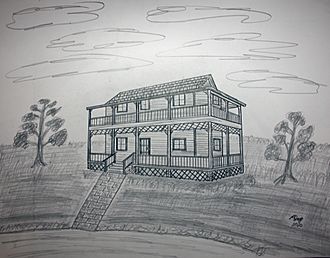St. Joseph's Plantation (Flagler County, Florida) facts for kids
Quick facts for kids St. Joseph’s Plantation (Flagler County, FL) |
|
|---|---|

Artist’s depiction of the main house of St. Joseph's Plantation – ca. 1835.
|
|
| General information | |
| Location | Palm Coast, Florida |
| Coordinates | 29°32′17″N 81°13′24″W / 29.53806°N 81.22333°W |
| Completed | 1816 |
The St. Joseph's Plantation was a large farm in Florida. It was started in 1816 during the time of Spanish rule. Joseph Marion Hernandez bought a big piece of land, about 807 acres. This farm was located near where Palm Coast Parkway and Old Kings Road are today in Palm Coast, Florida.
This plantation was a place where people were forced to work. They grew crops like sugar cane and corn. For many years, until the 1970s, you could still see parts of the old buildings and roads. But these ruins were later removed to build new homes and shops in Palm Coast.
Contents
What the Plantation Was Like
In 1835, a visitor from the Caribbean wrote about St. Joseph's Plantation. He said it had the best soil in Florida for farming. He noted that Joseph Marion Hernandez had worked hard to clear and drain the land. Over 200 acres of swampy land were used for farming. The visitor believed these swampy lands were even better for growing sugar than the famous farms in the Caribbean.
Crops and Workers
Reports from 1844 show that St. Joseph's Plantation was a large and complex farm. It was located next to Graham Swamp, near the Matanzas River. At least 80 enslaved people were forced to work there. They grew many different crops. These included 200 acres of sugar cane and 200 acres of corn. They also grew peas and potatoes.
Buildings and Systems
The plantation had many important structures. There were roads, bridges, and causeways. Large canals helped with drainage. Some canals were up to seven feet deep and over a mile long. There was also a system of smaller ditches. These helped drain over 200 acres of land.
Besides the main house, there were many other buildings. A stone boiling house was used to process sugar. It was connected to a curing house. This building had special areas for molasses. There was also a mill house with a steam engine. This engine had iron rollers to grind sugar cane. Other buildings included a corn house and a pumpkin house. There were also sheds for cattle, a fodder house, and a blacksmith shop. Houses for the enslaved workers were also on the property. The plantation also had oxen, horses, tools, and farm machines.
Military Use During War
During the Second Seminole War, the Florida Militia took over the plantation. They called it Camp Brisbane. The main house became a storage area on the first floor. The second floor was used as a hospital. Soldiers also built defenses around the house using logs.
St. Joseph's Plantation became a key supply base for the militia. It supported their actions south of St. Augustine, Florida. The soldiers used the plantation's resources. They stopped its farming operations. They also took or destroyed much of its property.
Abandonment of the Plantation
After a battle in January 1836, the militia was defeated. The troops retreated to Bulowville. Later, they were ordered to move to St. Joseph's/Camp Brisbane. However, the hospital there was not ready for all the wounded soldiers. So, the troops left St. Joseph's Plantation on January 28, 1836. They moved to St. Augustine.
This left the plantation empty and unprotected. Soon after, in 1836, the Seminole Indians and their allies took what was left. They then burned most of the buildings to the ground.
Attempts to Rebuild
Joseph Marion Hernandez asked the United States government for money. He wanted about $100,000 for the damage to his plantation. In 1839, he received some money. He got more payments until 1842, totaling about $39,521. In 1844, he asked for the rest of the money, but his request was denied.
Even with some money, it was not enough to fully rebuild the plantation. Hernandez did manage to grow some sugar and syrup. But the income was not enough to keep the plantation going.
What Happened to It
In 1850, Joseph Marion Hernandez moved to Cuba. The remaining parts of St. Joseph's Plantation were left empty. Over the years, they slowly fell apart. People also took things from the site.
Today, nothing of the original St. Joseph's Plantation can be seen above ground. The area has been completely redeveloped with new buildings and roads.

